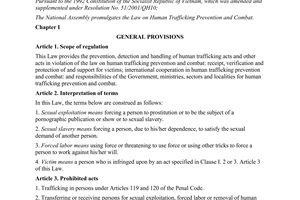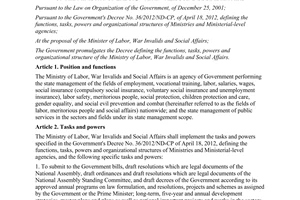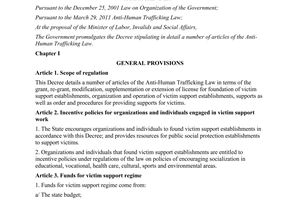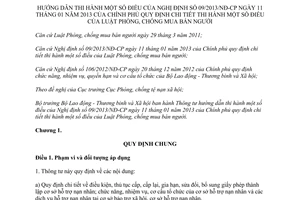Nội dung toàn văn Circular No. 35/2013/TT-BLDTBXH guidelines No. 09/2013/ND-CP detailing Law on prevention of human trafficking
|
MINISTRY OF LABOR, WAR INVALIDS AND
SOCIAL AFFAIRS |
SOCIALIST REPUBLIC OF VIETNAM |
|
No. 35/2013/TT-BLDTBXH |
Hanoi, December 30, 2013 |
CIRCULAR
GUIDELINES FOR SOME ARTICLE OF THE GOVERNMENT'S DECREE NO. 09/2013/ND-CP DATED JANUARY 11, 2013 DETAILING THE LAW ON PREVENTION OF HUMAN TRAFFICKING
Pursuant to the Law on Prevention of human trafficking dated March 29, 2011;
Pursuant to Government's Decree No. 09/2013/ND-CP dated January 11, 2013 detailing the Law on Prevention of Human trafficking;
Pursuant to the Government's Decree No. 106/2012/ND-CP dated December 20, 2012, defining the functions, tasks, powers and organizational structure of the Ministry of Labor, War Invalids and Social Affairs;
At the request of the Director of Department of Social Issue Prevention;
The Minister of Labor, War Invalids and Social Affairs promulgates a Circular on guidelines for the Government's Decree No. 09/2013/ND-CP dated January 11, 2013 detailing the Law on Prevention of Human trafficking,
Chapter 1.
GENERAL PROVISIONS
Article 1. Subjects and scope
1. This Circular deals with:
a) Conditions, procedures for issuing, reissuing, and adjusting Licenses for establishment of victim assistance centers; functions, tasks, and organizational structure of victim assistance centers, and victim assistance services at social protection establishments and victim assistances centers.
b) Procedures for victim assistance
c) Standards for quality of victim assistance services at receiving, rescuing, and assisting bodies.
2. This Circular is applied to organizations and individuals assigned to provide assistance for victims in accordance with the Law on Prevention of Human trafficking.
Article 2. Rules for providing assistance for human trafficking victims
1. The conditions and standards prescribed in this Circular must be adhered to when victim assistance services are being provided.
2. Victim assistance services must be provided in accordance with guidance on expertise of the Ministry of Labor, War Invalids and Social Affairs.
Chapter 2.
CONDITIONS FOR ESTABLISHMENT, PROCEDURES FOR ISSUING, REISSUING, AND ADJUSTING LICENSES FOR ESTABLISHMENT; FUNCTIONS, TASKS, AND ORGANIZATIONAL STRUCTURE OF VICTIM ASSISTANCE CENTERS, AND VICTIM ASSISTANCE SERVICES AT SOCIAL PROTECTION ESTABLISHMENTS AND VICTIM ASSISTANCES CENTERS
Article 3. Conditions for establishment of a victim assistance center
Apart from satisfying the conditions in Point a, Point b, and Point c Clause 1 Article 4 of the Government's Decree No. 09/2013/ND-CP dated January 11, 2013 detailing the Law on Prevention of Human trafficking (hereinafter referred to as the Decree No. 09/2013/ND-CP) the following conditions must also be satisfied:
1. Infrastructure:
a) Receipt room:
- At least 10 m2 in area;
- Having essential equipment serving receipt of victims, including desks, chairs, document cabinets, computers, telephones;
- Having a board showing internal regulations and victim assistance services.
b) Victim's room:
- The minimum area per person is 05 m2, no more than 04 people are allowed in the same room. The rooms must be sturdy and have sufficient lighting, windows, and lockable doors;
- There are essential equipment serving everyday life of victims while staying at the center such as beds, lockers, and personal belongings.
c) The victim assistance center must have a kitchen, eating room, bathroom, and other ancillary constructions; ensure security, order, and victims’ safety; comply with fire safety regulations.
If the victim assistance center is capable of 25 people or more, there must be separate areas for females, children, and old people, shared areas, water supply and drainage system, electricity, internal roads, medical equipment, and medicines serving first aid whenever necessary.
2. Personnel:
Apart from satisfying the conditions mentioned in Point d Clause 1 Article 4 of the Decree No. 09/2013/ND-CP the victim assistance center must satisfy the following conditions:
a) There must be at least a full-time employee. If part-time employees are employed, their working hours must be registered to ensure security of the center and victims;
b) Employees that directly provide assistance for victims must meet social worker’s standards in the Circular No. 34/2010/TT-LDTBXH dated November 08, 2010 of the Ministry of Labor, War Invalids and Social Affairs;
c) Health workers (if any) must have at least junior college degrees in medicine; security guards must have certificates of training in security in accordance with law.
Article 4. Application for License for establishment of a victim assistance center according to Article 7 of the Decree No. 09/2013/ND-CP
1. An application form for the License for establishment of a victim assistance center (the template is provided in Appendix 1 enclosed herewith).
2. A plan for establishment of a victim assistance center (the template in Appendix 2 enclosed herewith).
3. A résumé of the Director of the victim assistance center, certified by the People’s Committee of the commune where that person resides or where the center is located (the template in Appendix 3 enclosed herewith); a tentative list of personnel of the victim assistance center (the template in Appendix 4 enclosed herewith).
4. Relevant documents:
a) Legitimate papers about rights to use land, ownership of house or property on land serving the operation of the victim assistance center;
b) Written opinion of the People’s Committee of the commune where the victim assistance center is located, expressing approval or disapproval of the establishment of the victim assistance center;
c) Qualifications and certificates proving expertise of the future personnel.
Article 5. Application for extension of License for establishment of a victim assistance center according to Clause 2 Article 13 of the Decree No. 09/2013/ND-CP
The application for extension consists of:
a) An application form for extension of the License for establishment of a victim assistance (the template is provided in Appendix 1 enclosed herewith);
b) A report on victim assistance at that time and plan for future operation (the template is provided Appendix 5 enclosed herewith);
c) The original License for establishment.
Article 6. Receiving, considering applications for issuance, reissuance, adjustment, and extension of License for establishment
1. Receipt of application for issuance, reissuance, adjustment, and extension of License for establishment of a victim assistance center:
a) The Service of Labor, War Invalids and Social Affairs of the province where the victim assistance center is going to be located shall receive the application;
b) When receiving the application, the Service of Labor, War Invalids and Social Affairs must give the applicant a receipt note (the template is provided in Appendix 6 enclosed herewith).
2. Consideration of the application for issuance, reissuance, adjustment, or extension of the License for establishment according to Article 8, Clause 5 Article 11, Clause 5 Article 12, and Clause 5 Article 13 of the Decree No. 09/2013/ND-CP:
a) The Director of the Service of Labor, War Invalids and Social Affairs shall establish a consider the issuance, reissuance, adjustment, or extension of the License for establishment according to Article 8, Clause 5 Article 11, Clause 5 Article 12, and Clause 5 Article 13 of the Decree No. 09/2013/ND-CP;
b) The composition of the commission: the chief is an executive officer of the Service of Labor, War Invalids and Social Affairs; the deputy chief is an executive officer of the Sub-department or Division of Social Issue Prevention, which is affiliated to the Service of Labor, War Invalids and Social Affairs; the secretary is an officer of the Sub-department or Division of Social Issue Prevention; members are representatives of social protection departments affiliated to the Service of Labor, War Invalids and Social Affairs, provincial police authority, and the Sub-department or Division of Social Issue Prevention.
3. The deadline for appraisal is specified in Article 8, Article 11, Article 12, and Article 13 of the Decree No. 09/2013/ND-CP.
4. The appraisal record template is provided in Appendix 7; the template of Decision on issuance/reissuance of license for establishment is provided in Appendix 8; the template of Decision on adjustment/extension of license for establishment is provided to Appendix 9 enclosed herewith.
Article 7. Inspections at victim assistance center according to Article 17 of the Decree No. 09/2013/ND-CP
1. Every 06 months or when necessary, the Service of Labor, War Invalids and Social Affairs shall establish an inspectorate to inspect the operation of the victim assistance center. Any violations discovered shall be dealt with by the Service or by another competent authority at the request of the Service.
2. For the violations mentioned in Clause 1 and Clause 2 Article 17 of the Decree No. 09/2013/ND-CP the inspectorate must make an inspection record using the template in Appendix 13 enclosed herewith. According to the seriousness of the violations, the Director of the Service of Labor, War Invalids and Social Affairs shall request President of the People’s Committee of the province to suspend the operation or revoke the license for establishment.
The template of the decision on suspension is provided in Appendix 14; the template of the decision on revocation of the license for establishment is provided in Appendix 15 enclosed herewith.
Article 8. Application and procedures for shutdown of victim assistance center according to Clause 2 Article 18 of the Decree No. 09/2013/ND-CP
1. An application for shutdown of a victim assistance center consists of:
a) An application form for the License for shutdown of victim assistance center (the template is provided in Appendix 10 enclosed herewith).
b) A plan for settling victims, employees, persons with relevant rights and benefits when the center is shut down (the template is provided in Appendix 11 enclosed herewith); a Decision on shut down of victim assistance center (the template is provided in Appendix 12 enclosed herewith)
2. Procedures for considering the shutdown of a victim assistance center:
a) Within 05 working days from the receipt of the application for shutdown, the Director of the Service of Labor, War Invalids and Social Affairs shall examine the plan for settling victims, employees, persons with relevant rights and benefits and request the President of the People’s Committee of the province in writing to decide the shutdown of the victim assistance center;
b) Within 05 working days from the receipt of the request from the Director of the Service of Labor, War Invalids and Social Affairs, the President of the People’s Committee of the province shall decide the shutdown of the victim assistance center;
c) If disputes between the victim assistance center and relevant parties arise, the Director of the Service of Labor, War Invalids and Social Affairs shall notify the victim assistance center and send documents to competent authorities for settlement.
Article 9. Functions and tasks of victim assistance centers
1. Receive and provide shelter for victims.
2. Fulfill the victims’ essential needs, provide healthcare and psychological counseling that suit the genders, wishes of victims, and capacity of the center.
3. Provide career counseling and training in social skills for victims.
4. Assess the victims’ ability to integrate into the community; provide information about policies, benefits, and victim assistance services in the community.
5. Provide necessary information for regulatory bodies to combat and prevent the prohibited acts in Article 3 of the Law on Prevention of Human trafficking.
6. Cooperate with relevant agencies in sending victims back to their home.
7. Cooperate with the police in identifying victims.
Article 10. Organizational structure of a victim assistance center
1. A victim assistance center has one Director, one or two Deputy Directors, and several departments, including:
a) Receipt department, administration department, security department;
b) Management department, consultancy department;
c) Community integration department.
2. Depending on the scale of the victim assistance center, the Director shall decide the establishment of other units to provide assistance for victims. Specific tasks of departments shall be decided by the Director.
Article 11. Victim assistance services at social protection establishment and victim assistance center
The social protection establishment and victim assistance center must provide the following services to support victims:
1. Receipt, fulfillment of essential needs, and victim protection:
a) Receive victims sent by regulatory bodies; provide them with shelter and food that suit their gender, age; provide clothes and necessary items while they are staying at the center;
b) Assist regulatory bodies in collecting information about human traffickers; protect the lawful rights of victims in proceedings. If the victim is a child or underage, guardian must be appointed, or an organization may be appointed to act as a guardian as prescribed by law;
c) Take measures to protect victims in accordance with law.
2. Provision of health care, psychological counseling, and legal advice:
a) Provide medical examination and treatment for ordinary diseases for victims. If a victim’s condition is beyond the medical competence of the center, he/she must be sent to a suitable medical facility;
b) Qualified personnel shall be appointed to counsel the victims in order to help them regain their composure; measures shall be taken to intervene in victims’ psychological crisis where necessary;
c) Send victims to legal consultancy centers to help them protect their lawful rights and interests where necessary.
3. Provision of compulsory education, vocational training; formulation of community integration plan:
a) Provide consultancy on compulsory education, vocational training, and career counseling for victims in need; send victims to suitable local educational institutions that provide compulsory vocational training;
b) Assess the victims’ ability to integrate into the community; provide victims’ with information about policies, benefits, and victim assistance services in the community; cooperate with the police authorities, Offices of Labor, War Invalids and Social Affairs, and the People’s Committees of the communes where victims resides to contact their families or relatives before sending them back
c) If the victim is a child, within 20 days before the expiration of residence period, the Director of the social protection establishment or victim assistance center must request the child’s family (parent or guardian) to take him/her home, or appoint an official to take him/her home. If the child is an orphan or homeless, the assistance mode shall be changed.
Chapter 3.
PROCEDURES FOR VICTIM ASSISTANCE AND STANDARDS FOR ASSESSING VICTIM ASSISTANCE SERVICE QUALITY
SECTION 1. VICTIM ASSISTANCE PROCESS AND PROCEDURES FOR APPLYING FOR FINANCIAL SUPPORT FOR VICTIMS IN THE COMMUNITY
Article 12. Assisting victims in community integration
1. Victim assistance process consists of all the steps and services meant to help victims regain the composure, physical condition, and social conditions that are necessary for community integration and social integration.
2. Steps of victim assistance:
a) Receive and provide initial assistance for victims;
b) Prepare the conditions for community integration;
c) Assist victims in integrating into the community.
3. According to the steps of victim assistance process mentioned in Clause 2 of this Article, social workers shall provide counseling and formulate a plan for assisting victims in community integration. The assistance services selected must be appropriate; the victims’ decisions must be respected.
Article 13. Initial assistance for victims
1. The People’s Committee of communes, the Offices of Labor, War Invalids and Social Affairs of districts, social protection establishments, victim assistance centers, the Vietnam’s representative bodies overseas , other rescuing and receiving bodies of the border guard, the police, and the coastguard shall receive and provide initial assistance for victims.
2. When receiving victims, the entities mentioned in Clause 1 of this Article must immediate fulfill victims’ essential needs (accommodation, clothes, food); inform victims of assistance policies and complete the procedures for taking them home; inform them of the vehicles, distance, and traveling time; inform their families or relatives before taking them home.
3. If victims need support or information is not sufficient to take them home, the receiving body shall send them to a local social protection establishment or victim assistance center to provide suitable assistance.
Article 14. Assistance in recovery, preparation of conditions for victims to integrate into the community
1. Assistance in recovery and preparation of conditions for victims to integrate into the community is carried out at social protection establishments and victim assistance centers. Those facilities shall provide services that help them recover from their psychological trauma and learn social skills before social integration. The maximum stay at a social protection establishment is 60 days; the stay at a victim assistance center depends on the conditions and capacity of the center.
2. Necessary services during this period: healthcare, legal support; career counseling, support policies of the state; introduction to suitable vocational training institutions; psychological counseling, preparation of other conditions for victims to integrate into the community.
Article 15. Assistance in community integration
1. Community integration is the stage in which victims are brought back to their community after they have recovered and provided with necessary conditions for establishing normal relationship with their families and society. The period of time needed for community integration depends on the background and capacity of each victim.
2. Social protection establishments, victim assistance centers, the People’s Committee of the communes are responsible for holding activities and provide services to assist victims in going back to their family and integrating into the community.
3. Assistance services include: assessing ability to integrate into the community, formulating victim assistance plans (including financial resources and officials); implementing victim assistance plans; supervising and assessing the assistance and adjusting the plan if necessary.
Article 16. Procedures for provision of financial support for compulsory education, vocational training, initial assistance for victims, and connection with victim assistance services in the community
1. An application for financial support for compulsory education, vocational training, and initial assistance for a victim mentioned in Point a Clause 3 Article 23 of the Decree No. 09/2013/ND-CP consists of:
a) An application form which is made by the victim or his/her family and certified by the People’s Committee of the commune (the template is provided in Appendix 16 enclosed herewith);
b) One of the following certifications:
- Certification of victim issued by a police authority of the district, town, or provincial city (hereinafter referred to as district) according to Clause 4 Article 24 of the Law on Prevention of Human trafficking;
- Certification of victim issued by a rescuing body according to Article 25 of the Law on Prevention of Human trafficking;
- Certificate of victim issued by an investigating body, a the People’s Procuracy, or a People’s Court;
- A paper proving the victimization issued by a foreign authority and consularly legalized by a Vietnam’s representative body overseas or the Ministry of Foreign Affairs of Vietnam.
2. Procedures for provision of financial support for compulsory education, vocational training, and initial assistance for victims shall be carried out in accordance with Point b Clause 3 Article 23 of the Decree No. 09/2013/ND-CP.
3. Providing and connecting victim assistance services in the community:
a) During assistance, depending on the capacity of the center and wishes of victims, the person assigned to provide assistance shall propose that the victims be transferred to another eligible service provider.
b) The organization or individual assigned to provide assistance for victims must receive victims that are transferred and provide them with assistance within the scope of their competence.
If victims are refused, explanation must be provided in writing.
SECTION 2. STANDARDS FOR ASSESSING VICTIM ASSISTANCE SERVICE QUALITY
Article 17. Standards for assessing victim assistance service quality
Standards for assessing victim assistance service quality in this Circular include:
1. Service quality standards when receiving, interviewing victims specified in Article 19 of this Circular;
2. Quality standards for recovery services and assistance in community integration specified in Article 20 of this Circular.
Article 18. Responsibility for supervising and ensuring victim assistance service quality
1. Providers of victim assistance services must ensure quality of victim assistance services.
2. Services of Labor, War Invalids and Social Affairs of provinces, shall carry out inspections to assess quality of victim assistance services according to the standards mentioned in Article 19 and Article 20 of this Circular; receive and settle complaints against quality of victim assistance services.
3. Encourage other organizations and individuals to supervise and assess quality of victim assistance services; cooperate with provider of victim assistance services and regulatory agencies in charge of victim assistance in assessing and controlling quality of victim assistance services.
4. Apart from ensuring quality of victim assistance services according to the standards in Article 19 and Article 20 of this Circular, victim assistance centers and social protection establishments must adhere to regulations on standards at social protection establishment in the Circular No. 04/2011/TT-BLDTBXH dated February 25, 2011 of the Ministry of Labor, War Invalids and Social Affairs.
Article 19. Quality standards when receiving, interviewing victims
When receiving and interviewing victims, the agency that receives, rescues, or provide assistance must ensure that:
1. Regulations of law on procedures for receiving and providing assistance for victims are complied with.
2. The environment is safe and amiable; officials appointed are suitable for the victims' genders and age; victims are not discriminated on grounds of nationality, ethnic group, religion, social class, physical condition, or gender.
3. Receiving officials must inform victims of the location, rules and regulations of the receiving center, and other necessary information.
4. Victims that resemble children must be treated as children though their real ages have not been determined. Victims must be interviewed and identified in the best interest of children.
Article 20. Quality standards for recovery services and assistance in community integration
1. Standards about provision of sufficient information about assistance services for victims:
a) Victims or their legal representatives are enabled to be provided with information about assistance services.
b) Victims' right to select assistance services is defended.
c) Service providers must actively approach, contact victims or their relatives to collect relevant information and documents;
d) Victims are provided with sufficient information about assistance services, except for confidential information and documents.
2. Standards for psychological counseling:
a) Psychology counseling must be provided when victims are received by qualified counselors;
b) Counselors establish a positive relationship with victims; ensure stable, comfortable mentality and concentration while giving psychological counseling; build up victims’ trust; promptly take measures for crisis intervention if necessary.
3. Quality standards for formulation and implementation of the plan for assistance in community integration:
a) The plan for community integration must be formulated according to assessment of ability, needs, strengths of victims, and accessible resources
b) Assistance activities and services must focus on victims’ needs; the plan must be regularly reviewed and adjusted to reality;
c) Victims may participate in the formulation of the plan for assistance in their community integration;
d) The purposes, contents, sources, executing entities, and schedule must be specified in the assistance plan.
Chapter 4.
IMPLEMENTATION
Article 21. Organization of implementation
1. The Director of Department of Social Issue Prevention shall assist the Minister of Labor, War Invalids and Social Affairs in providing guidance, carry out inspection and supervision of the implementation of this Circular.
2. Presidents of the People’s Committees of provinces shall direct Services of Labor, War Invalids and Social Affairs and relevant agencies to implement this Circular.
Article 22. Transition
Victim assistance centers established before this Circular takes effect may keep operating. By August 15, 2014, victim assistance centers must apply for licenses for establishment and operation in accordance with the Decree No. 09/2013/ND-CP and this Circular.
Article 23. Effect
1. This Circular takes effect on February 15, 2014.
2. The Circular No. 05/2009/TT-BLDTBXH dated February 17, 2009 of the Ministry of Labor, War Invalids and Social Affairs on organizational structure and operation of victim assistance centers under the Prime Minister’s Decision No. 17/2007/QD-TTg dated January 29, 2007 is abolished.
Difficulties that arise during the implementation of this Circular should be reported to the Ministry of Labor, War Invalids and Social Affairs for consideration./.
|
|
PP THE MINISTER |
------------------------------------------------------------------------------------------------------
This translation is made by LawSoft and
for reference purposes only. Its copyright is owned by LawSoft
and protected under Clause 2, Article 14 of the Law on Intellectual Property.Your comments are always welcomed



